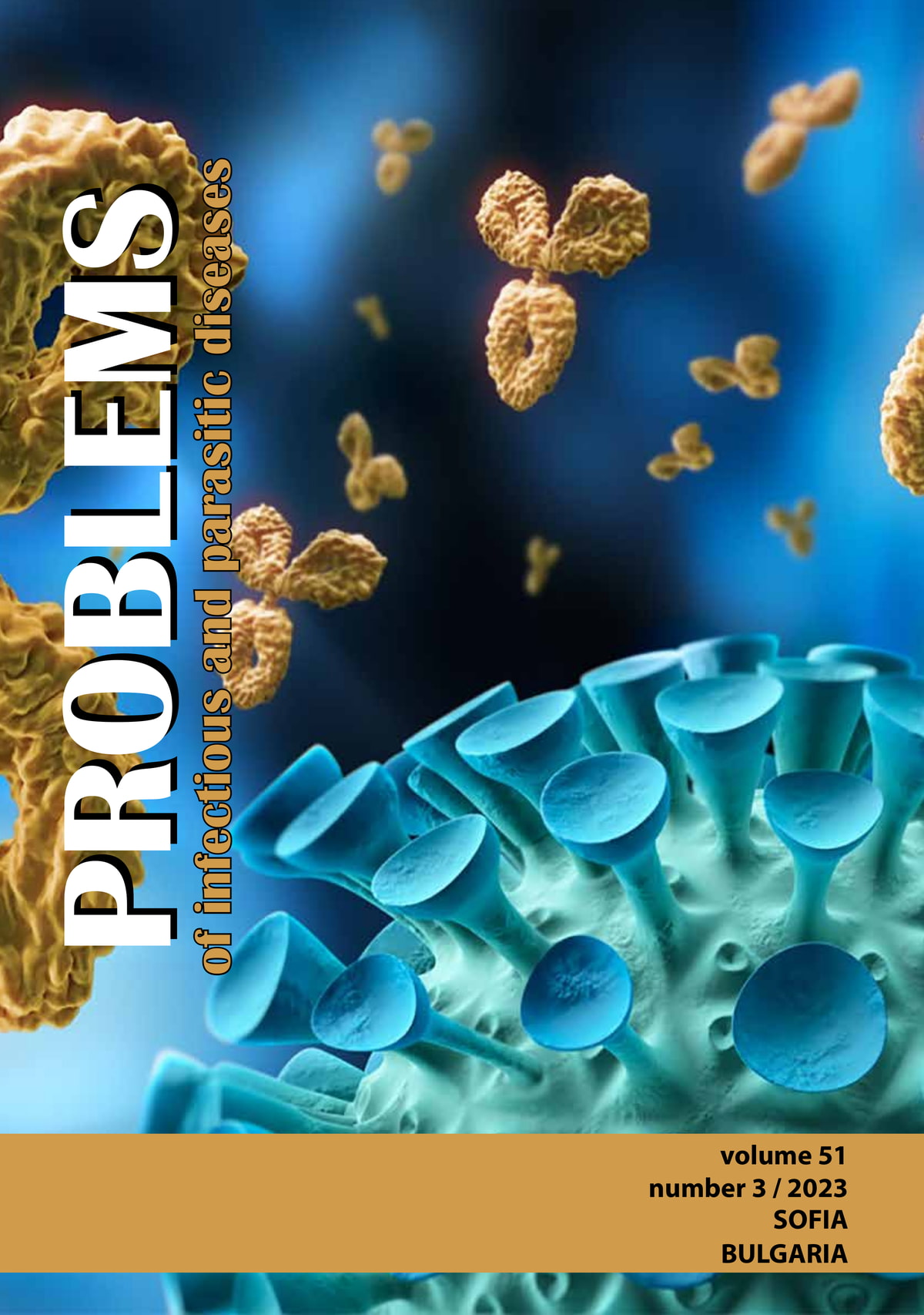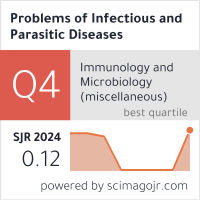RARE CASE OF ASCARIASIS DETECTED BY COLONOSCOPY ON THE BACKGROUND OF ELEVATED LEVELS OF FECAL CALPROTECTIN
DOI:
https://doi.org/10.58395/7x6e3005Keywords:
Ascariasis, Ascaris lumbricoides, Ascaris suum, faecal calprotectin, colonoscopyAbstract
Introduction: The causative agents of ascariasis in humans are two species: Ascaris lumbricoides and Ascaris suum. For diagnosis, a fecal sample is most often examined. In some cases, the parasite can be identified when coming out with the intestinal passage, and very rarely up on colonoscopy.
Aim to present a rare case of ascariasis where the diagnosis was made by colonoscopy on the background of elevated levels of fecal calprotectin (f-CP).
Case presentation: A colonoscopy was performed on a 52-year-old female patient due to elevated f-CP. The patient had no complaints. The colonoscopy did not detect pathological changes of the intestinal mucosa, but documented larval stages of Ascaris spp. freely moving in the lumen of the large intestine. The patient was treated with albendazole. Subsequent parasitological examinations of fecal samples were negative.
Discussion: In developed countries, the transmission of Ascaris lumbricoides is greatly reduced. On the background of a very limited transmission of Ascaris lumbricoides, many authors consider that most of the sporadic cases of ascariasis are due to Ascaris suum. In the case described by us, the f-CP levels normalized after the treatment, and for this reason, we cannot categorically reject the relationship between Ascaris infection and elevated f-CP levels.
Conclusion: The presented clinical case is of interest due to the unusual way of diagnosi ascariasis. In the absence of clinical symptoms, and pathological changes of blood and biochemical parameters, except for elevated fecal calprotectin, inflammatory colon disease was suspected and was colonoscopy performed on this occasion.
Downloads
References
Montresor A, Mupfasoni D, Mikhailov A, Mwinzi P, Lucianez A, et al. The global progress of soil-transmitted helminthiases control in 2020 and World Health Organization targets for 2030. PLOS Neglected Tropical Diseases 2020; 14(8): e0008505. https://doi.org/10.1371/journal.pntd.0008505
Leles, D., Gardner, S.L., Reinhard, K. et al. Are Ascaris lumbricoides and Ascaris suum a single species?. Parasites Vectors 2012; 5, 42 https://doi.org/10.1186/1756-3305-5-42
Holland C, Sepidarkish M, Deslyper G, Abdollahi A, Valizadeh S, Mollalo A, Mahjour S, Ghodsian S, Ardekani A, Behniafar H, Gasser RB, Rostami A. Global prevalence of Ascaris infection in humans (2010-2021): a systematic review and meta-analysis. Infect Dis Poverty. 2022; 11(1):113. https://doi.org/10.1186/s40249-022-01038-z
Harizanov R, Kaftandjiev I, Rainova I, Tsvetkova N, Borisova R, Videnova M, Kaneva E, Mikov O, Ivanova A, Yakimova V. Prevalence of parasitic pathology among humans in Bulgaria: A retrospective cohort study over a two-year period (2020 – 2021). Probl. Inf. Parasit. Dis. 2022; 50(2): 26-34. https://doi.org/10.58395/pipd.v50i2.93
Rainova, I., Harizanov, R., Tsvetkova, N., Borisova R, Kaftandjiev I, Kaneva E, Ivanova A, Mikov, O., Videnova, M. Status of parasitic diseases in Bulgaria in 2018. General Medicine 2020; 22(1): 13 – 18.
Pathirana WGW, Chubb SP, Gillett MJ, Vasikaran SD. Faecal Calprotectin. Clin Biochem Rev. 2018; 39(3):77-90.
Patel C, Keller L, Welsche S, Hattendorf J, Sayasone S, Ali SM, Ame SM, Coulibaly JT, Hürlimann E, Keiser J. Assessment of fecal calprotectin and fecal occult blood as point-of-care markers for soil-transmitted helminth attributable intestinal morbidity in a case-control substudy conducted in Côte d’Ivoire, Lao PDR and Pemba Island, Tanzania. E Clinical Medicine. 2021; 32:100724. https://doi.org/10.1016/j.eclinm.2021.100724
Lamberton PH, Jourdan PM. Human ascariasis: diagnostics update. Curr Trop Med Rep. 2015;2(4):189–200. https://doi.org/10.1007/s40475-015-0064-9
Betson M, Nejsum P, Bendall RP, Deb RM, Stothard JR. Molecular epidemiology of ascariasis: a global perspective on the transmission dynamics of Ascaris in people and pigs. J Infect Dis. 2014;210(6):932–41. https://doi.org/10.1093/infdis/jiu193
Harizanov R. Ascariasis. In: Laboratory diagnostics of parasitosis (R. Kurdova editor), Arso, 2009, 173-174. 11. Monteiro KJL, Calegar DA, Santos JP, Bacelar PAA, Coronato-Nunes B, Reis ERC, Boia MN, Carvalho-Costa FA, Jaeger LH. Genetic diversity of Ascaris spp. infecting humans and pigs in distinct Brazilian regions, as revealed by mitochondrial DNA. PLoS ONE. 2019;14(6):e0218867. https://doi.org/10.1371/journal.pone.0218867
Zhou C, Chen J, Niu H, Ouyang S, Wu X. Study on the population evolution of Ascaris lumbricoides and Ascaris suum based on whole genome resequencing. Vet Parasitol. 2020; 279:109062. https://doi.org/10.1016/j.vetpar.2020.109062
de Gier B, Pita-Rodríguez GM, Campos-Ponce M, van de Bor M, Chamnan C, Junco-Díaz R, Doak CM, Fiorentino M, Kuong K, Angel-Núñez F, Parker ME, Perignon M, Rojas-Rivero L, Berger J, Polman K, Wieringa FT. Soil-transmitted helminth infections and intestinal and systemic inflammation in schoolchildren. Acta Tropica, 2018; 182:124-127. https://doi.org/10.1016/j.actatropica.2018.02.028
Salman YJ, Ali CA, Razaq AA. Fecal calprotectin among patients infected with some protozoan infections. Int. J. Curr. Microbiol. App. Sci. 2017; 6(6): 3258-3274. https://doi.org/10.20546/ijcmas.2017.606.384
Downloads
Published
Issue
Section
License
Copyright (c) 2024 Rumen Harizanov, Iskren Kaftandjiev, Iskra Rainova, Nina Tsvetkova (Author)

This work is licensed under a Creative Commons Attribution 4.0 International License.






